Sit Down, Have Some Plaid!
Sunday, July 22, 2012
More stuff sometime
So I'd like to blog more, but drawing my stupid doodles take a while, so maybe I'll try some makeup/craft related posts. I've got some products that I've been using that I could talk about & some craft projects too. So... hey. Maybe I'll be on here more.
Tuesday, November 15, 2011
Musles
So I have an exam on muscles tomorrow. It's more just about muscle contraction and action potential... so... PICTURES.
Say you've got a muscle. Well in that muscle is made up of a bajillion fascicles. Then those fascicles are made up of a bajillion muscle fibers... Then inside those muscle fibers are myofibrils, which divide into actin and myosin filaments. I understand what this picture looks like. Try and get over your Freudian slip.
So sarcomeres are the basic contractile unit of the muscle Sarcomeres are made up of actin and myosin filaments.
Actin are the "thinner" filaments, and myosin are "thicker."
To recap what I said like four sentences ago, myosin and actin are the main components involved in the contraction of muscles.
Myosin LOVES actin. Like really loves actin.
That's it for now. Sorry. This was kinda weird.
Say you've got a muscle. Well in that muscle is made up of a bajillion fascicles. Then those fascicles are made up of a bajillion muscle fibers... Then inside those muscle fibers are myofibrils, which divide into actin and myosin filaments. I understand what this picture looks like. Try and get over your Freudian slip.
So sarcomeres are the basic contractile unit of the muscle Sarcomeres are made up of actin and myosin filaments.
Actin are the "thinner" filaments, and myosin are "thicker."
To recap what I said like four sentences ago, myosin and actin are the main components involved in the contraction of muscles.
Myosin LOVES actin. Like really loves actin.
Actin likes myosin too, but not that much. Actin has myosin-binding sites that, when at rest, are blocked by tropomyosin. Think of tropomyosin as actin and myosin's chaperone.
However, when calcium ions enter the picture, troponin comes in, binds, and moves tropomyosin away from the myosin-binding sites.
Sunday, November 13, 2011
Is this how you fashion?
I have had some free time this weekend, and I really feel like writing, so I asked Tumblr what I should blog about. I have around 200 followers, so I thought I'd get some kind of legitimate response. Instead, one person answers with, "Fashion."
Really? Me? Fashion?
Really? Me? Fashion?
Today's outfit includes an ill fitting grey t-shirt, hot pink, winter themed fleece PJ pants, and slippers. To compliment my look, I created a smoky eye look by smearing yesterdays mascara across my face.
Instead of blogging about fashion, I've started typing up some good stuff about the Twilight series in honor of the release of Breaking Dawn. I'm excited.
Monday, October 31, 2011
Learn some pathophysiology with me!
Sorry I haven't made a post in a while. Nursing school kind of sucks up all of my time. However, I am currently in ZOO 325, which is Pathophysiology. In order to study for an exam, I drew some pictures! So if you want to learn about Immunity, then here you go!
BODY DEFENSES
So there are two (2) kinds of defenses that your body puts up.
- Non Specific Defenses
- Specific Defenses
There are some major defense organs, like the thymus, spleen, and lymphatic system.
The thymus, which is made out of lymphatic tissue and is larger in children, builds immunities to good and bad antigens. It also makes and houses T-Cells. This gland shrinks with age.
The spleen is the largest lymphatic organ. It is highly vascularized, which means there is always a lot of blood going through it. It has two parts, the red pulp and the white pulp. The red pulp is filled with blood (that’s why it’s red ;) ). It is a test site for erythrocytes (Red blood cells) and macrophages like to hang out there. The white pulp traps debris and holds lymphocytes (B and T Cells).
The lymphatic system acts as a filter for interstitial fluid. It is made up of lymph nodes, are like traps. These nodes can become inflamed when you are sick.
Non specific body defenses act as the first line against pathogens. There are mechanical as well as biological methods of non specific body defenses. I will first talk about Non-SpecificMechanical Defenses.
Your epithelium (SKIN) is one major mechanical defense. It is there, coming in contact with all sorts of antigens and pathogens. As long as it is in tact, it is a good barrier. It is closely joined so that it is not leaky. It is also a secretory system, and it repairs itself quickly.
Mucus is also a good mechanical, non specific defense. Mucus is made up of glycoproteins and water. Mucus traps, holds, and removes things like dust, pathogens, and viruses. Mucus is not only in your nose, but in the trachea and gut. For example, it offers protection, like in the stomach lining.
Flushing is the action of materials moving quickly out of the body. The most common example would be tears flushing particles out of your eyes, but flushing also happens in the gut. Think of when you eat some questionable Taco Bell at about 1 am… When you get the runs, that is an example of flushing! YEA SCIENCE. Flushing also occurs in the nose (sneezing), and when you pee (urinary tract!)
Digestive actions are also a good non specific mechanical body defense. It happens in, not only your gut, but in the eyes, too! It is basically just enzymes getting rid of bad/foreign particles.
Biological body defenses are also very important.
Inflammation is a biggie. It helps trap and block invaders, then sets up an environment for tissue repair. It also triggers an immune response with the help of cytokines (interleukins and interferons).
Fever is also a biological defense. Your body is able to raise its temperature in order to make a hostile environment for pathogens.
There are also some cells that work as biological defenders. Macrophages are the most popular. The word “Macrophage” literally means “big eater.” They ingest and process pathogens, then present the antigen (think of it as a little flag on pathogens that let others know what it is) on the surface of Antigen Presenting Cells (APCs), which are usually Helper T cells. Then, they clear the cellular debris. Polymorphonucleocytes (PMNs) are also part of this defense, as well as symbionts, and follicle mites.
And then there is Specific Immunity. Specific immunity is acquired. That means that it is not innate (you are not born with it), and it is learned by your body. It is also adaptive, meaning it responds to the environment. Specific immunity is based on specialized proteins & cells, which offer cell-based immunity or humoral immunity. In cell-based immunity, there are cells that attack invaders in the tissues. In humoral immunity, specialized proteins and antibodies attack invaders in the body fluids. So remember, cell-based means in the tissues and humoral means in the fluids.
The big cells that are the specific defenders are called LYMPHOCYTES. Lymphocytes are produced from stem cells in bone marrow, or in the liver and spleen in a fetsus’s case. Lymphocytes are released as undifferentiated cells. Some of them will move to the thymus, and some will stay in the bone marrow.
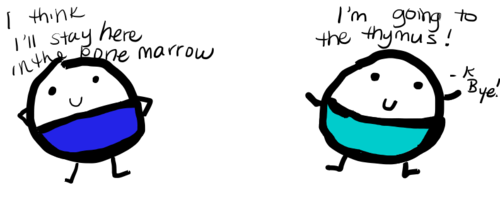
These cells are then “trained” in their respective tissues to become either B cells or T cells. This is called becoming IMMUNOCOMPETENT. The cells are now about to recognize antigens, but they have not been exposed yet. They are also learning how to differentiate “SELF” from “ENEMY.” You wouldn’t want these guys attacking your own cells, so they need to learn what is a friend and what is a foe.
After the cells become immunocompetent, they move into the peripheral lymphatics or tissues. There, they wait to be “deployed.”
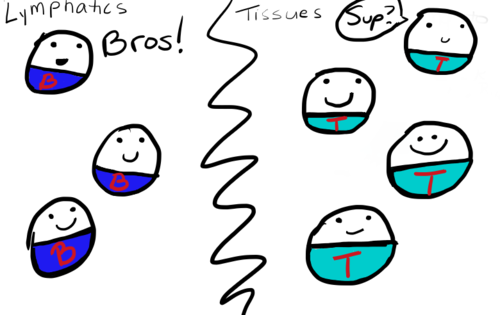
CELL MEDIATED IMMUNITY
Cell mediated immunity involves the T-Cells!
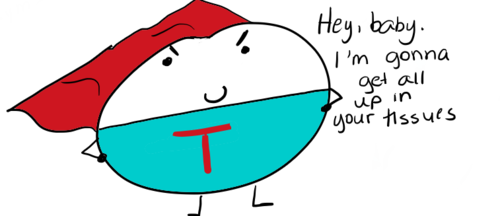
T-Cells are able to recognize antigens because of T-Cell Receptors located on their cell membrane. They are specific for specific antigens.
T-Cells are used to attack BIG things, like abnormal cells, intracellular viruses, fungi, parasites, neoplasms, and foreign tissues (like a transplanted kidney). T-Cells also release cytokines, which call for an immune response. T-Cells can stimulate and control immune functions, and they attract macrophages and PMNs to the area for backup.
There are several types of T Cells!
Cytotoxic T Cells (Tc) are the main soldier T Cell. They directly attack invaders or other cells by using toxins.
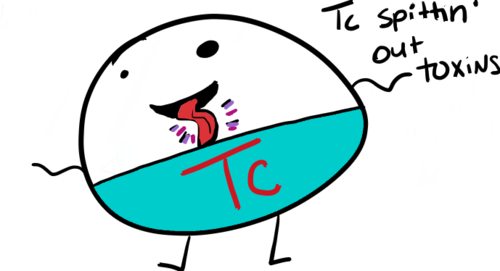
There are also Helper T Cells (Th) that act as a communicator or liaison between the cellular and humoral immunity systems. The Th cells interact with Antigen Presenting Cells (APCs) and they can activate more T Cells and B Cells.
Memory T cells are used as a secondary immune response after a person has already been exposed to that particular antigen.
Suppressor T Cells work to inhibit Tc and antibody production.
And then there are Natural Killer T Cells (NK) that are able to recognize and interact with an antigen without prior exposure. The are innate, so you are born with them. Think of them as the Rambo of your T Cells. They are most sensitive to antigens on infected cells and neoplasms, but they are not truly specific to one antigen. They can also attack cells or other invaders that are covered with antibodies (antibodies like to cover the “bad guys” in order to signal to other cells that there is a bad guy).
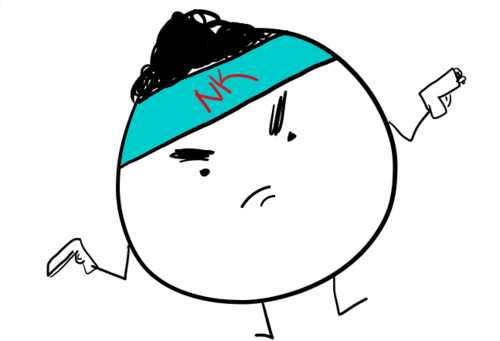
Humoral Immunity/Antibody-Mediated
In a Humoral Immunity response, the cells do not attack, but create antibodies that will attack.
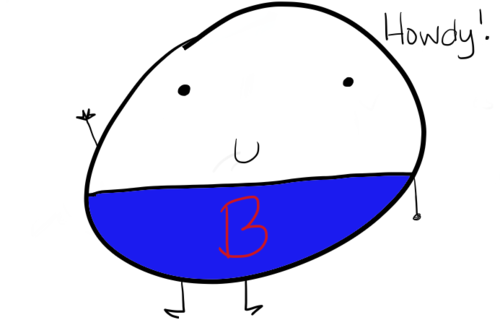
This involves the B Cells. B Cells are not named “B” because they come from the bone marrow, but because they were originally found in the bura of fabricias in birds. The human’s equivalent would be the bone marrow, liver, or spleen.
After becoming immunocompetent, B Cells acquire either IgD or IgM antibodies (their receptors). Then, they go to the peripheral lymphatics, where they wait to be used.
When the B Cells are activated, they differentiate into Plasma Cells. The plasma cells move into the blood and circulate. The plasma cells produce antibodies at the rate of about 2,000 cells/second. B Cells can also differentiate into Memory B Cells.
Antibodies like to attack little things, like bacteria, viruses, and toxin molecules. They will “cover” larger cells. This alerts Natural Killer T cells and Cytotoxic T Cells that there is a bad guy.
There are five types of Antibodies that I am studying, which are IgA, IgD, IgE, IgG, and IgM.
IgA antibodies are secretions of exocrine glands (ducted glands). They come from thinks like breast milk, tears, snot, sweat, urine, and bile. They offer localized protection, and are tuned into viruses and bacteria.
IgD antibodies form receptors on B Cells.
The antibody that has the lowest concentration is the IgE antibody. They attack parasites and allergies, and mostly attach to mast cells.
The most abundant antibodies are IgG antibodies. They enhance phagocytosis, neutralize toxins, and they cross the placenta to help protect the fetus.
IgM antibodies are the antibodies that are first produced during a primary response. So when your body comes in contact with an antigen it has never encountered before, IgM antibodies are produced. They are also involved in blood typing.
Here’s a graph of the primary immune response in relation to antibodies.
As you can tell, the number of IgM antibodies increases first because you are coming in contact with a new antigen. Then, levels of IgG antibodies increase in order to get rid of the bad guys.

In a secondary immune response, the number of IgG antibodies increases at a quick rate because your body remembers that antigen because of the Memory T Cells and Memory B Cells that are produced.
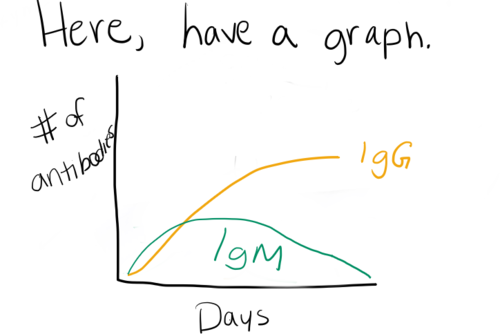
So say a bacteria enters your body. Well, that bacteria has a little antigen on it. A macrophage wants that antigen in order to process it and determine what antigen it is.
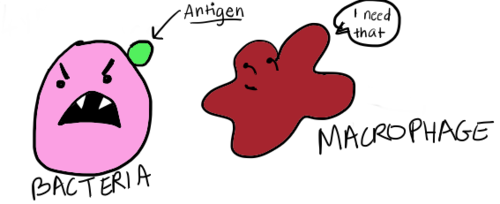
The macrophage takes the antigen, using its MHC II receptor, presents the antigen to a T Helper “zero” cell by activating Interleukin 1. The Th0 cell has a T Cell Receptor on it that, along with a CD4, is able to recognize and process that antigen.
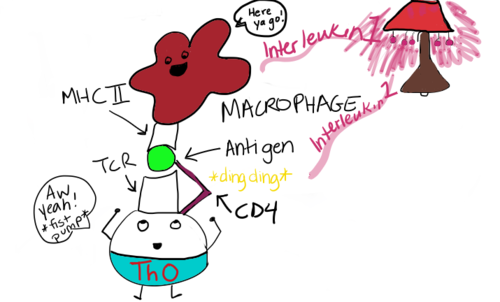
This process then activates an actual T Helper cell. Using the cytokines Interleukin 4 or Interleukin 12 to start either a Cellular or Humoral response. The Th cell can also use Interleukin 2 to clone itself.
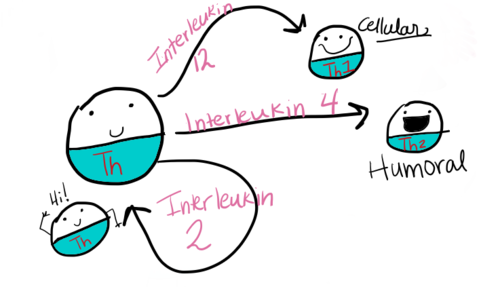
In a cellular response, The Th1 cell uses Interleukin 2 to activate a Cytotoxic T Cell. The Tc uses its T Cell Receptor and CD8 to recognize a “bad guy.”
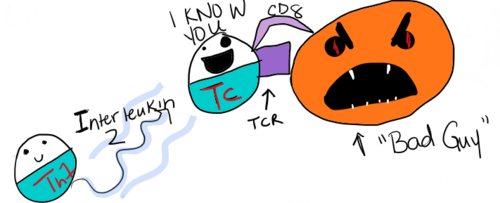
In a humoral response, the Th2 cell uses Interleukin 4 to activate a B cell, which takes the antigen, engulfs it, processes it, and displays it outside on it’s cell membrane.
I’m running out of study time, so no drawing.
Subscribe to:
Posts (Atom)





